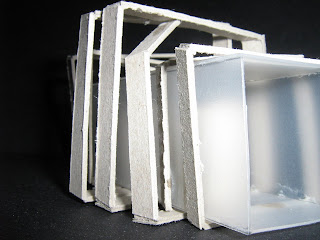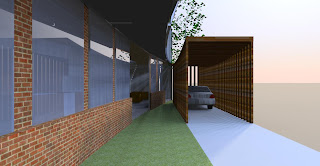
Tuesday, November 4, 2008
Wednesday, September 17, 2008
the splitting edge



This design expresses the ideas and concepts of cutting, slicing and then further explores theresult of what may happen once its been cut.
This concept has been approachedby taking this idea and using it ontwo large masses rother than four.The overall mass is a long curved form which as been sliced in the middlelenghtways to cause it to slide out of place, Creating a horizontal ‘split’ at one end.
Entry from the site to theresidence is located at the splitof the residence. The entrance is a long pavilion.This can be usedas a relaxation area or for access into the residence or garage.
Access from the Pavilion to the residence is allowed by stairs that are located in the garage area.
The two blocks have been made seperate for the purpose that it has been split. Not necessarly from one another but to convey the ideaof the two occupants on each blockliving seperate lives.
The two blocks have been made seperate for the purpose that it has been split. Not necessarly from one another but to convey the ideaof the two occupants on each blockliving seperate lives.
Tuesday, August 19, 2008
Submission 1- equus
DESIGN 1 - You'll find that when you cut an object they often do not hold their original shape. The cut pieces will shift, twist, flake and appear to have changed size once they start to fall. This design tries to convey these ideas of object configuration through the process of shifting, twisting, and pulling. This has been done by wrapping a solid object around a glass tube. The object wrapping the glass tube was once a intergrated with the glass tube.. but once been cut it lost its shape and it shifted, twisted and pulled away from the tube structure. DESIGN 1
DESIGN 1
.JPG) DESIGN 1
DESIGN 1

 DESIGN 1
DESIGN 1.JPG) DESIGN 1
DESIGN 1DESIGN 2- This design explores the ideas of a open cut wound. Once been cut by a sword, the cut isnt just one line representing a cut but it opens up creating an oval shape. Roof structure is an oval shape that peals up.. the pealing represents the lifting and swelling of a wound. The oval shape of the roof assists the curves of the walls as the walls follow the form of the roof. The wall extends out creating a single long wall.. this represents the bleeding when the blood runs out the edge of the cut. On one side of the building the walls overlap. This comes from the idea of the layering and healing process of a flesh wound.

DESIGN 2
.JPG)
.JPG)
DESIGN 2
.JPG)
.JPG)
DESIGN 3- this design shows the idea of cutting and slicing. The glass represents whats been taken away through slicing.. and the solid is whats been lift. It also shows the instability of cutting an object as the solid areas have been pushed in to show the movement and shifting of the object.
 DESIGN 3 -
DESIGN 3 -

 DESIGN 3 -
DESIGN 3 -
DESIGN 3


DESIGN 4- Once again the design is exploring the idea of cutting into the facade. The building has been seperated by been cut in the middle and the negative been replace with glass. The units 1,2,3 and 4 also show the cutting of the facade, by a repitition of slicing down the length of the wall.

DESIGN 4
 DESIGN 4
DESIGN 4


DESIGN 4
 DESIGN 4
DESIGN 4
Tuesday, August 12, 2008
looking at concepts

open cut wound.... the affects a sword may have on the flesh.

exploring the ideas of piercing, cutting, slicing... taken from the idea of swords.
Hejduks version of the curator of armor:
The japanese Helmet, Kabuto, with its large neckguard was usually adorned with a ferocious mask of a dragon. Armor was used until the third quarter of the 19th century. He also collected swords, he built a room with tatami flooring to keep his collection. He respected the tea ceremony but dislike the taste of the bitter green drink.
Tuesday, August 5, 2008
 Curator of Japanese armor-Museum of Japanese armor
Curator of Japanese armor-Museum of Japanese armorSitting silently, all alone in the closet he watched as the fire shots entered his parent’s body and came out the other end. Blood was everywhere, on the two stone cold bodies, the floor and the walls. His parents were now gone but somewhere in the house still remained his younger sister. Although he had to rescue her from the intruders he couldn’t come out from the closet. The young boy sat breathing out hot air but at the same time breathing in the instant stink of the two bodies lying in front of him.
Suddenly two objects came through what was left of the door. In the light the tall objects shined like gold and silver. Once the objects came out of the bright light they appeared to be two tall Samurai’s. The Samurai’s were too quick for the white man’s gun, they both flied through the air like eagles, with both swords going through the man’s body. As the large swords pierced the intruder’s body he fell back, he fell back onto the fragile closet landing onto the young boy’s body. As the man fell onto the young boys body the sword that had come out of the man’s back pierced the skin of the delicate four year olds skins, wounding him. The boy lost so much blood he passed out. After waking up the first thing he saw was the large piece of chest armor hanging over him. It was silver with a gold dragon in the middle, and then out from the corner of his eyes he saw his younger sister. Relieved, he passed out again.
Fifty years on the invasion on Japan had past and the young boy is now a curator of ancient Japanese armor in the national museum of Japan. After the horrific loss of his parents the curator grew an obsession for Japanese armor. It was as though the sight of the chest armor had left a scare just like the knife had scared his body. The mental and physical scaring was there to remind him every day of how he lost his parents and who was there to rescue himself and his sister. For that he was forever grateful to the warriors of Japan and felt like he had to serve as a way of repayment. Not only is he a curator of Japanese armor but he also fell in love with the history of Samurai’s and know teaches at the University of Kyoto. Passing on his passion of ancient Japanese warriors to the youth of Japan gave the curator strength to not seek revenge for what happened to his parents but to honour the hero’s Japanese history.
Subscribe to:
Comments (Atom)












.JPG)


